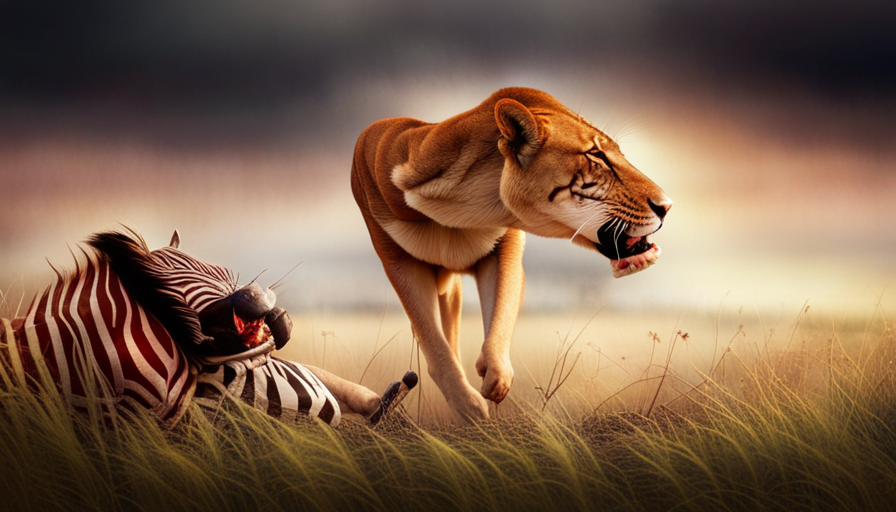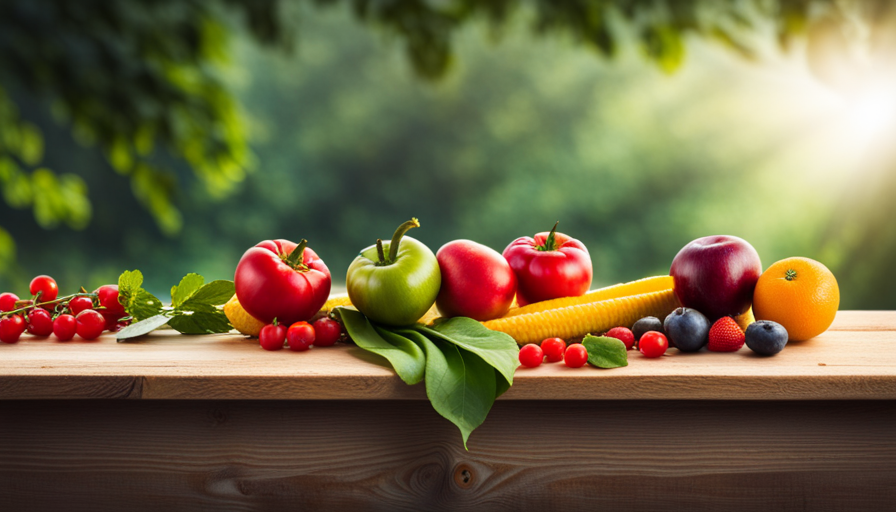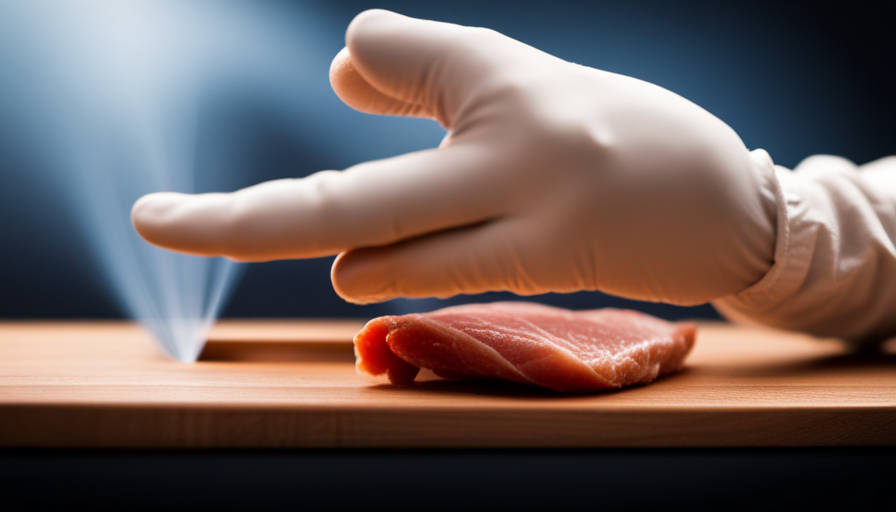Were you aware that more than 80% of wild animals eat their food raw?
It’s fascinating to think about how different species have evolved unique ways to eat raw food, whether it’s tearing into raw meat, grinding and chewing raw plants, or adapting to a mixed raw diet.
In this article, we will explore the various methods and adaptations that animals use to consume raw food, from their beaks, teeth, and jaws to specialized tools for cracking nuts and seeds.
We will also delve into the digestive adaptations and health benefits of raw food diets in the animal kingdom.
By understanding how animals eat raw food, we can gain insights into the potential benefits and risks of the raw food movement for humans.
So, let’s embark on this scientific journey to uncover the secrets of how animals tackle their raw meals!
Key Takeaways
- Different species have unique ways of eating raw food, with carnivores tearing into raw meat with sharp teeth and digestive enzymes, herbivores grinding and chewing raw plants with specialized teeth and lengthy digestive tracts, and omnivores being able to digest both plant fibers and animal proteins.
- Consuming raw meat carries health risks due to harmful bacteria and parasites, but omnivores have a stronger immune system and shorter digestive tract to mitigate these risks.
- Beaks, teeth, and jaws are evolutionary adaptations for raw food consumption in omnivores, while specialized tools are essential for cracking nuts and seeds.
- Some animals swallow food whole using muscular throats and esophagus, such as snakes with stretchy and expandable throats, and birds with muscular esophagus for swallowing.
Carnivores: Tearing Into Raw Meat
Carnivores can’t resist tearing into raw meat; it’s like an irresistible feast for their primal instincts. Their predatory instincts kick in as they sink their sharp teeth into the flesh, tearing it apart with precision. But it’s not just their teeth that make them efficient raw meat eaters; it’s also their digestive enzymes.
These enzymes, such as proteases, are secreted in the carnivores’ stomachs. They break down the proteins in the raw meat into smaller, more manageable pieces. This process allows for better absorption of nutrients and energy. Additionally, the high acidity of their stomachs helps kill any harmful bacteria that may be present in the raw meat.
As carnivores tear into raw meat, they also benefit from the natural enzymes present in the meat itself. These enzymes aid in the digestion process, further breaking down the meat and making it easier for the carnivores to extract the essential nutrients.
Transitioning to herbivores: grinding and chewing raw plants, it’s important to note that not all animals rely on tearing and ripping their food. Herbivores have evolved a different approach to consume raw plants, which involves grinding and chewing.
Herbivores: Grinding and Chewing Raw Plants
As an herbivore, you’ll find yourself joyfully munching on raw plants, grinding and chewing them into a delightful, nourishing meal. Herbivores have developed various grinding techniques and digestive adaptations to efficiently consume raw plants. Here are four fascinating aspects of their eating process:
-
Specialized Teeth: Herbivores possess unique dental structures to aid in grinding plant material. For instance, horses have large, flat molars that facilitate grinding, while rabbits have continuously growing incisors to compensate for the wear caused by constant chewing.
-
Lengthy Digestive Tracts: Herbivores have longer digestive tracts compared to carnivores, allowing for prolonged digestion of cellulose-rich plant matter. This enables them to extract as many nutrients as possible from their raw diet.
-
Fermentation Chambers: Some herbivores, such as cows and sheep, have specialized compartments in their stomachs called fermentation chambers. These chambers contain symbiotic bacteria that help break down tough plant fibers through fermentation.
-
Chewing and Rechewing: Herbivores often engage in a process called rumination. They initially chew and swallow plant material, and later regurgitate it to chew it again. This second chewing helps further break down the food and enhance digestion.
As herbivores have adapted to efficiently consume raw plants, omnivores have developed their own strategies for adapting to a mixed raw diet.
Omnivores: Adapting to a Mixed Raw Diet
To truly embrace the diverse flavors and textures of a mixed raw diet, I, as an omnivore, have ingeniously adapted to incorporate a wide range of nourishing options into my culinary repertoire.
Over the course of evolution, my species has developed various adaptations that allow us to thrive on both plant and animal-based foods. One of the key evolutionary adaptations for omnivores like me is our ability to digest a variety of foods. Our digestive system is equipped with enzymes that can break down both plant fibers and animal proteins. This flexibility allows us to extract the maximum amount of nutrients from the food we consume.
However, there are also health risks associated with consuming raw foods. Raw meat, for example, may contain harmful bacteria and parasites that can cause foodborne illnesses. To mitigate these risks, our bodies have developed a stronger immune system and a shorter digestive tract, which reduces the time for potential pathogens to multiply and cause harm.
As we move into the subsequent section about beaks, teeth, and jaws: evolutionary adaptations for raw food consumption, it is important to understand how these adaptations have further enhanced our ability to thrive on a mixed raw diet.
Beaks, Teeth, and Jaws: Evolutionary Adaptations for Raw Food Consumption
With beaks, teeth, and jaws, I have evolved to possess specialized tools that aid in the efficient consumption of a mixed diet, like the woodpecker’s strong beak for drilling into trees to extract insects. These evolutionary adaptations allow me, as an omnivore, to consume raw food in various forms. While my beak is designed for specific purposes, my teeth and jaws also play crucial roles. My teeth are shaped and positioned to tear, crush, and grind food, while my jaws have the strength and flexibility to handle different textures and sizes.
To further illustrate the significance of these adaptations, consider the following table:
| Adaptation | Purpose |
|---|---|
| Beak | Drilling into trees to extract insects |
| Teeth | Tearing, crushing, and grinding food |
| Jaws | Handling different textures and sizes |
These evolutionary adaptations allow me to effectively consume raw food. However, there are other specialized tools that come into play when it comes to cracking nuts and seeds, which will be discussed in the subsequent section.
Transitioning into the next section, specialized tools are essential for cracking nuts and seeds.
Specialized Tools: Cracking Nuts and Seeds
Using their specialized tools, creatures have evolved to crack nuts and seeds with precision and ease. Cracking shells is a challenging task that requires specific adaptations.
-
Beak shape: Birds like the finch have developed strong and pointed beaks that allow them to apply pressure on the shell, cracking it open. The size and shape of the beak vary depending on the type of nut or seed they consume.
-
Powerful jaws: Some animals, such as squirrels, possess strong jaws that can exert significant force to break open hard shells. Their teeth are adapted to withstand the pressure and grinding motion required for this task.
-
Specialized teeth: Rodents like rats have incisors that continuously grow, allowing them to gnaw through shells. These teeth are sharp and ideal for cracking open tough exteriors.
Cracking nuts and seeds is a vital part of these animals’ diet. Once the shells are open, they can access the nutritious contents inside. This method of raw food consumption by cracking is just the first step in the process.
The subsequent section will explore how animals have adapted to swallowing food whole.
Swallowing Whole: Raw Food Consumption by Gulping
Imagine gulping down your entire meal in one go, no chewing required! Many animals have developed swallowing techniques that allow them to consume raw food by simply gulping it down. These animals have specialized anatomical features and digestive enzymes that enable them to process and extract nutrients from their food without the need for chewing.
When an animal swallows its food whole, it relies on its muscular throat and esophagus to quickly transport the food from the mouth to the stomach. Some animals, like snakes, have a stretchy and expandable throat that allows them to swallow prey much larger than their own head. Others, like birds, have a muscular esophagus that contracts and relaxes to move the food down.
Once the food reaches the stomach, digestive enzymes go to work. These enzymes break down the raw food into smaller molecules that can be absorbed and utilized by the animal’s body. The stomach of these animals is designed to handle the raw food, with a highly acidic environment that aids in the breakdown and digestion process.
Swallowing whole is a remarkable adaptation that allows animals to consume raw food efficiently. However, not all animals rely on this method. In the subsequent section, we’ll explore another method of raw food consumption: ripping and tearing by predators.
Ripping and Tearing: Raw Food Consumption by Predators
Predators have developed powerful jaws and sharp teeth to tear through their prey, showcasing a brutal and efficient method of consuming raw food. These evolutionary adaptations allow them to effectively rip and tear the flesh, enabling them to access the nutrient-rich parts of their prey.
The sharp teeth of predators, such as lions or tigers, are perfectly designed for puncturing and gripping the tough hides and muscles of their prey. With their strong jaws, they can apply immense force to tear off chunks of flesh, bones, and tendons.
Consuming raw food through ripping and tearing has its advantages. Firstly, it allows predators to access the vital nutrients present in the raw meat, such as proteins, fats, and vitamins, which are crucial for their survival. Additionally, this method of consumption minimizes the risk of losing nutrients through cooking or processing. However, there are also potential health risks associated with raw food consumption. Prey animals may carry harmful bacteria or parasites that could be transferred to the predator, leading to infections or diseases.
Transitioning to the subsequent section about fermentation and digestive adaptations in raw food diets, it is important to understand how predators have further evolved to overcome the challenges of consuming raw food.
Fermentation and Digestive Adaptations in Raw Food Diets
Evolved with the efficiency of a well-oiled machine, predators’ digestive systems have transformed into fermenting factories, unlocking the hidden nutrients of their primal feasts. Fermentation, a process that breaks down complex molecules into simpler ones, plays a crucial role in the digestion of raw food for these animals.
The benefits of fermentation are numerous. Firstly, it allows predators to extract more energy from their food by breaking down tough plant cell walls and releasing the nutrients trapped within. Additionally, fermentation produces volatile fatty acids, which serve as a valuable energy source for these animals.
Digestive enzymes also play a vital role in the digestion of raw food. These enzymes, such as amylase and protease, break down carbohydrates and proteins respectively, enabling predators to extract the essential nutrients from their prey. The high acidity of their stomachs further aids in the breakdown of raw food, ensuring that no potential nutrients go to waste.
Transitioning into the subsequent section about ‘raw food diets in the animal kingdom: health benefits and risks’, it is clear that predators have adapted their digestive systems to efficiently process raw food. However, not all animals thrive on raw diets, and there are both health benefits and risks associated with this type of diet.
Raw Food Diets in the Animal Kingdom: Health Benefits and Risks
Transitioning into the world of raw food diets, it’s fascinating to explore the health benefits and potential risks that come with this dietary choice in the animal kingdom.
Animals that consume raw food diets have been found to experience a range of health benefits. Firstly, raw food diets provide animals with a higher intake of essential nutrients compared to cooked or processed foods. This is because cooking can destroy certain vitamins and minerals, reducing their availability for absorption. Additionally, raw food diets help animals maintain their natural weight and body composition. This is because raw foods are generally less calorie-dense than cooked foods, allowing animals to eat larger quantities without gaining excess weight.
However, it’s important to note that there are also potential risks associated with raw food diets in the animal kingdom. One major concern is the risk of bacterial and parasitic infections. Raw foods can harbor harmful bacteria such as Salmonella and E. coli, which can cause serious illnesses in animals. Another risk is the potential for nutritional imbalances. Raw food diets may lack certain essential nutrients, such as calcium and vitamin D, which can lead to deficiencies over time.
Exploring the raw food movement for humans: inspiration from animal eating habits, we can learn valuable lessons about the potential health benefits and risks of consuming raw foods.
Exploring the Raw Food Movement for Humans: Inspiration from Animal Eating Habits
After exploring the health benefits and risks of raw food diets in the animal kingdom, I was inspired to delve into the raw food movement for humans. As a proponent of healthy eating, I’ve always been curious about the benefits and challenges of this dietary approach.
The raw food movement has gained popularity among humans seeking a healthier lifestyle. Supporters believe that consuming raw foods provides numerous benefits, such as increased intake of vitamins, minerals, and enzymes. Additionally, raw food enthusiasts claim that this diet can improve digestion and boost energy levels.
However, the raw food movement also poses certain challenges. One of the main concerns is meeting nutritional requirements, as some essential nutrients are more easily absorbed when cooked. Moreover, maintaining a balanced raw food diet can be challenging due to limited food options and the need for careful meal planning.
To fully understand the raw food movement, it’s important to consider both its benefits and challenges. By embracing this lifestyle, individuals can experience the potential health advantages associated with raw food consumption, but they must also navigate the potential pitfalls to ensure a well-rounded and nutritionally balanced diet.
Frequently Asked Questions
How do animals ensure they are getting all the necessary nutrients from a raw food diet?
Ensuring nutrient absorption is crucial for animals on a raw food diet, and they have ingenious ways to achieve this. They possess a highly advanced digestive system that maximizes nutrient uptake. Their teeth, jaws, and enzymes are perfectly adapted to break down raw food into easily absorbable forms.
Additionally, animals have a remarkable ability to detect nutrient deficiencies and instinctively seek out the necessary foods. This natural instinct ensures that they obtain all the required nutrients from their raw food diet, reaping its numerous benefits.
Are there any risks or drawbacks to animals consuming a raw food diet?
There are indeed risks and drawbacks to animals consuming a raw food diet. Firstly, there’s an increased risk of bacterial and parasitic infections, as raw food may contain harmful pathogens.
Additionally, a raw food diet may lack essential nutrients such as calcium, vitamin D, and certain vitamins and minerals. This can lead to nutritional deficiencies and health issues.
Furthermore, raw bones can pose a choking hazard or cause dental fractures. Therefore, it’s important to consider these risks before feeding animals a raw food diet.
How have animals evolved physically to consume raw food?
Animals have undergone evolutionary adaptations and physical changes to consume raw food.
Over time, their teeth and jaws have evolved to be better suited for tearing and chewing raw meat or plant material.
For example, carnivorous animals have sharp teeth and strong jaws for effectively breaking down raw meat.
Herbivorous animals, on the other hand, have developed specialized teeth and digestive systems to efficiently process raw plant material.
These evolutionary adaptations enable animals to extract the necessary nutrients from raw food for their survival and well-being.
Do all animals have the ability to digest raw food, or are there some that cannot?
Not all animals have the ability to digest raw food. While some animals, like carnivores, have short digestive systems that can handle raw meat, others, like herbivores, have longer digestive systems that are better suited for processing plant matter.
However, animals with shorter digestive systems can still benefit from a raw food diet, as it provides them with essential nutrients and enzymes that can be lost during cooking.
Are there any animals that have adapted to consume a specific type of raw food, such as nuts or seeds?
Animals have indeed adapted to consume specific types of raw food. For example, some primates have evolved to eat fruits and nuts by developing specialized teeth and jaws to crack open tough shells.
Similarly, herbivores like cows and horses have adapted to consume grasses by having a specialized digestive system, including a large fermentation chamber, to break down the tough cellulose found in plants.
These adaptations allow animals to efficiently extract nutrients from their raw food diet and thrive in their respective environments.
Is a Whole-Food Raw Diet Suitable for All Animals, Including Wild Animals?
Feeding a labrador raw diet is not suitable for all animals, wild or domestic. While some wild animals may thrive on raw diets, others may not. It is important to consider the specific nutritional needs of each species before deciding on their diet.
Conclusion
In conclusion, observing the various ways animals eat raw food is a captivating journey into the intricate world of nature’s design. From the powerful jaws of carnivores tearing into raw meat to the meticulous grinding and chewing of herbivores, each species has evolved unique adaptations to thrive on a raw diet.
Beaks, teeth, and jaws have been finely tuned over time, allowing animals to extract every ounce of nutrition from raw plants. Specialized tools aid in the cracking of nuts and seeds, while predators rely on ripping and tearing to consume their prey.
Moreover, fermentation and digestive adaptations play a crucial role in breaking down raw food for optimal nutrient absorption. While raw food diets offer potential health benefits, it’s important to consider the risks associated with such a diet.
By exploring the raw food movement for humans, we can draw inspiration from the incredible eating habits of animals and make informed choices about our own nutrition.










